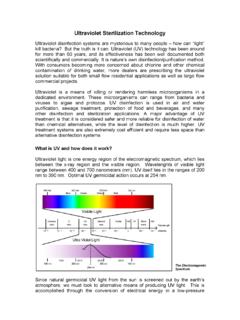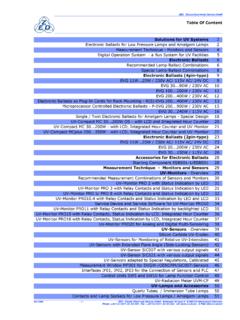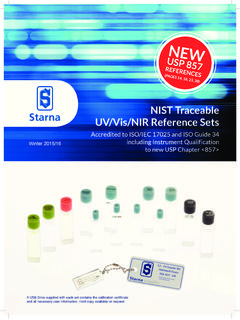Transcription of Protection Against Exposure to Ultraviolet Radiation
1 Protection Against Exposure to Ultraviolet Radiation PREFACE This INTERSUN report provides information to people on how to protect themselves from the potentially harmful effects of Exposure to Ultraviolet (UV) Radiation . Following a detailed review of the scientific literature conducted by a WHO Task Group meeting convened under joint sponsorship with the United Nations Environment Programme and the International Commission on Non-Ionizing Radiation Protection , a number of adverse health effects resulting from Exposure to UV have been identified that need to be addressed through further research and more particularly through educational programmes for people most exposed to UV. The purpose of this report is to provide information to the general public and workers on the various health hazards known to be associated with excessive Exposure to UV and measures that can be taken to reduce this Exposure to acceptable levels.
2 This publication was co-sponsored by the World Health Organization, United Nations Environment Programme, Government of Japan and United States Army Center for Health Promotion and Preventive Medicine. A working group was kindly hosted by the US Army Center for Health Promotion and Preventive Medicine in Baltimore in August 1994. It comprised the following members: Professor M Belkin Tel Aviv University, Tel Hashomer, Israel Dr J-P C sarini Fondation Rothschild, Paris, France Professor B Diffey Dryburn Hospital, Durham, England Dr M Hietanen Finnish Institute of Occupational Health, Helsinki, Finland Dr M Kojima Kanazawa Medical University, Ishikawa, Japan Dr G Mariutti National Institute of Health, Rome, Italy Dr A McKinlay National Radiological Protection Board, Didcot, England Dr M Repacholi Royal Adelaide Hospital, Adelaide, Australia (WHO Secretariat)
3 Dr C Roy Australian Radiation Laboratory, Yallambie, Australia Dr R Rubenstein Environmental Protection Agency, Washington, DC, USA Dr D Sliney Army Center for Health Promotion and Preventive Medicine, Aberdeen, MD, USA Professor F Urbach Temple University, Philadelphia, PA, USA Dr S West Wilmer Eye Institute, Baltimore, MD, USA Mr U Wester Swedish Radiation Protection Institute, Stockholm, Sweden The comments received by various specialists in the field are very much appreciated. INTRODUCTION Skin cancer and cataracts are important public health concerns. The social cost of these diseases, such as death, disfigurement and blindness, can be overwhelming both in terms of human suffering and the financial burden. Much of this could be avoided by reducing Exposure to solar UV.
4 The sun is the principal source of UV Exposure for most people. Exposure to the sun is known to be associated with various skin cancers, accelerated skin aging, cataract (opacity in the lens of the eye) and other eye diseases, and possibly has an adverse effect on a person's ability to resist infectious diseases. The United Nations Environment Programme has estimated that over 2 million non-melanoma skin cancers and 200,000 malignant melanomas occur globally each year. In the event of a 10% decrease in stratospheric ozone, with current trends and behaviour, an additional 300,000 non-melanoma and 4,500 melanoma skin cancers could be expected world-wide. Some 12 to 15 million people are blind from cataracts. WHO has estimated that up to 20% of cataracts or 3 million per year could be due to UV Exposure .
5 Given that, in the United States alone, it costs the US Government $US billion for million cataract operations per year, substantial savings in cost to health care can be made by prevention or delay in the onset of cataracts. WHAT IS UV? The sun's emissions include UV, visible light, heat and other radiations. These emissions are characterized by their wavelength, expressed in manometers (1 nm = 10-9 m). As visible light can be divided into colours which we can see in a rainbow, UV is subdivided and commonly defined as UVA, UVB and UVC. All UVC (very short wavelength UV) is absorbed by the atmosphere and does not reach the earth's surface. UVB is biologically damaging UV, but most of this is absorbed by the atmosphere. Long wavelength UVA is the most intense UV reaching the earth and can penetrate furthest into tissue, but it is not as biologically damaging as UVB.
6 OZONE Ozone is a form of molecular oxygen existing predominantly in the upper atmosphere. It is continuously formed by oxygen absorbing the sun's short-wave UVC and then broken down by a number of chemicals, such as chlorine from chlorofluorocarbons (CFCs), and by absorption of UVC and UVB. Since ozone is an effective absorber of UV, depletion of the stratospheric ozone layer results in people and the environment being exposed to higher intensities of UV, particularly UVB. Recent reports suggest that the protective ozone layer is being depleted at a rate sufficient to leave "holes" over the Antarctic, causing higher UV exposures to residents of New Zealand and the southern parts of Australia. Ozone holes have now been reported over parts of Europe and North America.
7 The consequences for humans and the environment of continuing ozone depletion and the resulting increases in UV Exposure have yet to be fully evaluated. FACTORS AFFECTING UV Exposure Solar elevation (height of the sun in the sky) The intensity of solar UV, and especially UVB, depends on the height of the sun in the sky. This will vary depending on the season of the year, time of day and latitude in which you live. UV intensities are highest during the summer months in the 4-hour period around noon (or 13:00 if daylight saving is in effect). UVB intensity varies more with the time of the day than does UVA. As a rule of thumb "when your shadow is shorter than your own height" you may receive half or more of the harmful UVB during the 4 hours around solar noon on a clear summer day.
8 In summer at noontime, UVB is two to three times more intense in equatorial areas than in northern Europe. At about 600 latitude the total UVB Exposure during the months of January and February can be less than one clear day's Exposure around midsummer. Latitude and altitude The UV intensity at the earth's surface is related to the angle at which the UV rays pass through the atmosphere. In the tropics (close to 00 latitude, or near the equator) solar UV is more intense because it has less distance to travel through the atmosphere to the earth's surface. UV intensities increase with altitude. This is because the amount of atmosphere available to absorb UV is reduced, and so more and shorter wavelength UV is able to reach higher altitude areas. In high altitudes, skiers can be exposed to higher intensities of UV, especially as snow is an excellent reflector.
9 Atmospheric scattering Solar UV is composed of direct and scattered Radiation . The sky looks blue because the blue rays from sunlight are highly scattered by the atmosphere. UV is scattered even more than blue light, and this can lead to an increase in a person's Exposure . Clouds and haze UV intensities are highest under cloudless skies. Clouds generally reduce UV intensity, but light or thin clouds have little effect and under certain conditions may even enhance the UV intensity. Hazy days generally have higher amounts of water vapour; UV scatter in the atmosphere increases and can result in a higher personal UV Exposure . Thus, even though haze or cloud cover can cause one to feel cooler, the UV Exposure can still be high. Ground reflection The reflective properties of the ground have an influence on UV Exposure .
10 Most natural surfaces such as grass, soil and water reflect less than 10% of incident UV. However, fresh snow strongly reflects (80%) UV. During spring in higher altitudes, under clear skies, reflection from snow could increase UV Exposure levels to those encountered during summer. Sand also reflects (10-25%) and can significantly increase UV Exposure at the beach. Reflected UV is an important source of Exposure to the eye. Acute effects, such as snow-blindness while skiing or photokeratitis at the beach, can result from UV reflected from snow or sand respectively. Factors affecting UV Exposure (Modified from Diffey BL and Lark O, Clinical climatology. Photodermatology 1984, 1:30-37. With permission.) HUMAN Exposure Outdoors For the majority of people the sun is the most important source of Exposure .


















